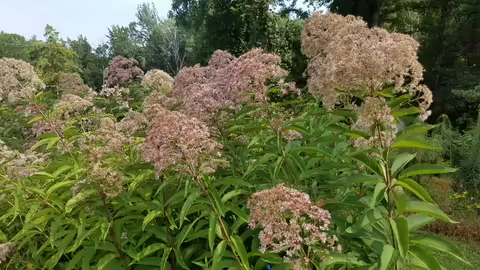One of my favorite plants of the late summer is the tall and tasseled titan, Joe-Pye Weed. This common name refers to several native species which often require an additional descriptive word to identify individuals, although many of us drop the descriptor and simply say “Joe-Pye Weed”.
To clarify, my favorite among this group of plants is “sweet” Joe-Pye weed (Eutrochium purpureum) due to its preference for dry and shady sites, which is unique. Its large white to purple-colored, composite flowers top towering stems in the late summer and continue their bloom period for about a month, becoming a popular pollinator stop.
I’ve often noted its preference among late season and migrating monarchs, not to mention a plethora of moth and bee species. In addition, it serves as a larval host to at least a half dozen native moths, making it a great plant for pollinators since it supports various life stages of these all-important insects.
Who was Joe Pye?
Beyond the plant’s ecological value and beauty, I have always marveled at its common name. Who was Joe Pye and why did they name a weed after him?
Over the years, I have read various accounts of how the name came to be in plant guidebooks and other botanical reference materials, with most mentioning a Native American (name Joe Pye) who used the plant medicinally in New England sometime around the early 1800’s.
Recently, while doing research on this plant and other relatives, I ran across a fascinating paper from 2017 in “The Great Lakes Botanist”, which is the Michigan Botanical Club’s peer-reviewed journal. The authors took a deep dive into the name Joe-Pye Weed to track down the actual person who is the plant’s namesake. As you might guess, there was much less botany involved in this common name’s genesis than there was history and I found it to be truly fascinating read.
The authors track the name’s history from the late colonial period and into the founding years of our country. It’s a fascinating time in history in and of itself with a plethora of written accounts that can be woven together to uncover the story of Joe Pye.
Without evidence, popular literature on wildflowers has included a variety of stories about Joe Pye over the years, with the most complex of these telling the tale of a member of the First Nations community that saved an entire colony from typhus fever by using one of the Joe-Pye Weed species medicinally. The authors questioned the accuracy of this story since no written account can be found of such a momentous feat.
Their research did tie the name Joe Pye to an actual man, named Joseph Shauquethqueat, who was a Mohican sachem (tribal leader) in the 18th and early 19th century. With the published journal of a fellow Mohican, Samson Occom, the authors were able to establish a connection between Shauquethqueat and the name Joe Pye.
They attributed the use of the name Joe Pye to the common usage, at the time, of Christian or white surnames by the First Nations community for the purpose of communication or conducting business. The surname Pye was well documented among English-speaking people of New England and had been in use by Mohicans since the 1730s or even earlier.
As a Mohican leader, Shauquethqueat is mentioned in various accounts of tribal business allowing the authors to document several events in his life and helping to establish his whereabouts and his role in the Stockbridge Mohican community. Its these written accounts that were the most fascinating to me, as they record exchanges between tribal leaders and British colonial governors as well as an exchange with George Washington, still the commander-in-chief of American forces, prior to his presidency.
Although interesting, the exchange with Washington in 1783 was a guarantee to safeguard the Stockbridge Mohicans migration to New York, which follows the sad and unfair pattern of white encouragement, resource depletion and forced migration that all of the First Nations people faced in the early history of our country. Washington offered this protection to the Stockbridge Mohicans out of respect for their efforts fighting bravely alongside Americans in the Revolutionary War.
No evidence for any miracle plant cure applied by Shauquethqueat was ever uncovered in this research and the formal connection between Shauquethqueat and our native plants cannot be made. This has left the authors to assume that, like most of the Mohican people of his time, Joe Pye did have knowledge of herbal medicine and likely had some connection to the plant that others observed, resulting in our current day common name association, although the direct link between Joe Pye and the plant world remains a mystery.
